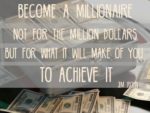Last updated on February 12th, 2025 at 10:45 am
 We’ve all been there – brilliant big dream ideas scattered across Post-It notes, decorating our bathroom mirrors, kitchen cabinets, and computer monitors like confetti after a parade. Each tiny square holds what could be the next big thing if only we could bridge the gap between “what if” and “what is.”
We’ve all been there – brilliant big dream ideas scattered across Post-It notes, decorating our bathroom mirrors, kitchen cabinets, and computer monitors like confetti after a parade. Each tiny square holds what could be the next big thing if only we could bridge the gap between “what if” and “what is.”
I know this firsthand. My Post-It note reading “Personalized fitness coaching for busy women who hate the gym” has sat on my mirror for months. I had the expertise as a fitness enthusiast, but turning that expertise into a viable business?
That felt like climbing Mount Everest.
The Million-Dollar Question
Why do so many potential innovations stay stuck in Post-It purgatory?
Enter Eric Ries, whose insights in Wired Magazine (Issue 19.09) and book “The Lean Startup” challenge everything we knew about launching a successful business. As the Lean Startup methodology creator and co-founder of IMVU (a platform that grew to 40 million users and $22 million in revenue by 2009), Ries shatters the most pervasive myth in entrepreneurship: that success comes from having the perfect idea at the ideal time. The evidence suggests quite the opposite.
Breaking Free from Post-It Prison: Your Action Plan
1. Start with a Minimum Viable Product (MVP)
Instead of building my entire dream vision at once, I identified a core feature that could solve the main problem. My MVP? A simple website with my contact information for workout preferences and a weekly email with personalized workouts. No fancy app, no complex website – just solving the core problem of personalized fitness guidance.
2. Embrace the Power of Feedback
I started small, sending workout reminders and collecting detailed feedback about what was working and what wasn’t. The insights were eye-opening: my target demographic needed shorter, more intense workouts and preferred video demonstrations over written instructions.
This feedback ultimately shaped my dream vision’s evolution.
3. Test Your Assumptions
My initial assumptions included:
• Busy professionals want home workouts (True)
• They need hour-long sessions (False – 15-30 minutes was optimal)
• They want daily check-ins (Mixed – weekly worked better)
Testing these assumptions early saved me from building an unnecessarily complex program.
4. The Power of Continuous Evolution
Instead of waiting to perfect my product behind closed doors, I embraced continuous deployment:
• Started with email-based reminders.
• Added short video demonstrations based on client requests.
• Introduced a simple group format for community support.
• Eventually, I want to develop a basic mobile app once demand proves strong.
Each addition came from actual client needs, not my assumptions.
5. Building Your Foundation
To move beyond ideas, you need a solid support structure. Here’s how I built mine:
• Resource Plan: Started with free tools (Google Forms, Gmail, WordPress, YouTube for videos, WhatsApp for community).
• Network: Joined entrepreneur groups and found a mentor.
• Documentation: Tracked client progress, feedback, and common questions.
• Milestones: Set a goal of 20 clients before investing in app development.
The key isn’t perfection – it’s progress. My plan is for my dream to evolve from email-based workouts to a comprehensive digital coaching platform, but you start with solving one simple problem well.
Beyond the Sticky Notes
Your million-dollar idea deserves more than a spot on your bathroom mirror. “The Lean Startup” offers a practical roadmap for transforming those Post-It dreams into market reality. Through this process, I discovered my real market wasn’t just busy professionals – it was explicitly working women of a certain age who needed flexible, efficient workouts that could adapt to unpredictable schedules.
Remember: Every successful company started with someone who decided to take that first step beyond the sticky note. My fitness coaching program incorporates women who want to be triathletes after age 40, but it began with two people and a website. Success rarely comes from having the perfect idea–it comes from executing, learning, and adapting quickly.
The time to start isn’t when everything is perfect. The time to start is now. Take that Post-It note, choose one miniature piece to test, and begin your journey from idea to reality. Start with one client, one workout, and one solution to one specific problem.
Your future customers are waiting.
Want to test your business idea? Start small as I have. Offer something free to three potential clients. Their feedback will tell you more about what the market needs than a thousand Post-It notes ever could.

Heather Montgomery is a fitness writer, triathlete, and serial entrepreneur who is devoted to sharing what she has learned about becoming a triathlete after age 40. She uses her Metabolic Training Certification to help other women struggling to get fit in mid-life. She lives and trains in Santa Rosa, California, the new home of the Ironman triathlon. You can find her biking the Sonoma County wine trails.
Note: Articles by Heather may contain affiliate links and will be compensated if you make a purchase after clicking on an affiliate link.




